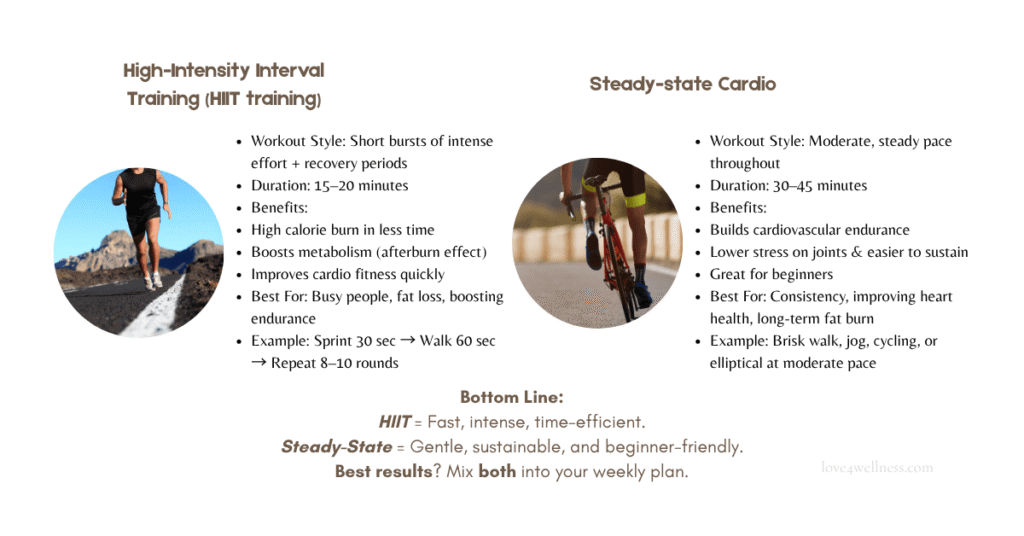While many factors contribute to it, the development of visceral fat is a common challenge for men over 40. The good news is that the solution is clear: a balanced regimen of cardio and strength training is the optimal way to lose this stubborn and dangerous fat. Why is this exercise combination so effective, specifically for men in this age group? And what practical steps should you take to start seeing results?
Crunches for abdominal fat: It’s a Myth!
Here’s the truth: crunches alone won’t flatten your belly. Spot reduction is a myth. If you want to lose visceral fat, you need to lower overall body fat. And the best way to do that? A smart mix of cardio and strength training is the most effective way for men to lose visceral fat.
Ready to transform your health? Let’s dive in.
Section 1: Cardio: More Than Just a Run
Cardio, or aerobic exercise, is essential because it burns calories. It not only helps you torch calories but also keeps your heart strong — a double win after 40. When you burn more calories than you consume, your body is forced to tap into fat stores (including the dangerous visceral fat around your organs).
When you think of cardio, you might picture endless hours on a treadmill. However, that’s not the only way to increase your heart rate. We’re going to work smarter, not just harder.

Your Secret Weapon: High-Intensity Interval Training (HIIT)
HIIT is your best friend when it comes to burning stubborn fat. Think of it as a series of short, explosive efforts followed by a little break. This isn’t just about burning calories while you work out; it’s about the “afterburn effect” (EPOC). Your body will keep burning calories at a higher rate for hours after you’ve finished, like a furnace that’s still hot long after the fire goes out.
A Simple HIIT Workout You Can Do Anywhere (15 minutes):
- Warm-up with a light jog for 3-5 minutes.
- Then, go all out! Sprint or run as fast as you can for 30 seconds.
- After that, slow down and walk for 60 seconds to recover.
- Repeat that cycle 8-10 times.
- Finish with a cool-down stretch.
If you’re new to this, start with a brisk walk and gradually increase the pace. The most important thing is to push yourself to that “all-out” feeling in your work phase.
Your Foundation: Steady-State Cardio
This involves maintaining a moderate intensity for a sustained period, such as brisk walking, cycling, or using an elliptical machine. While it doesn’t have the same “afterburn” as HIIT, it’s fantastic for cardiovascular health, endurance, and overall calorie burn. Aim for 30-45 minutes, 3-4 times per week.
Section 2: Strength Training: Build Your Metabolic Engine
If cardio helps you burn fat today, strength training helps you burn fat tomorrow. Why? Because building muscle speeds up your resting metabolism, you’re burning more calories all the time — even when you’re sitting at your desk. The more muscle you have, the faster your resting metabolism. Think of every new pound of muscle as a tiny furnace, constantly working to speed up your metabolism.
The most effective way to achieve this is through compound movements that engage multiple muscle groups simultaneously.
Your Essential Lifts:
- Squats: The king of exercises. It works your legs and glutes while strengthening your core.
- Deadlifts: A full-body powerhouse. It’s tough, but it’s one of the best for building overall strength and a strong back.
- Push-ups: A classic for a reason. You’ll build strength in your chest, shoulders, and arms.
- Rows: Balances out your push-ups by strengthening your back and biceps.
- Overhead Press: Great for building strong shoulders.
A solid plan is to do 2-3 full-body strength sessions a week. Just pick a few of these, and aim for 3 sets of 8-12 reps.
Section 3: The Best Core Exercises (For Strength, Not Fat Loss)
Remember, crunches won’t burn the fat off your stomach, but strengthening your core is still vital. A strong core improves posture, protects your back from injury, and makes all your other exercises more effective.
Effective Core Exercises:
- Plank: This exercise works your entire core, including your deep abdominal muscles.
- Leg Raises: Targets the lower abdominal muscles and builds strength in this area.
- Wood Chops: A rotational exercise that works your obliques, giving you functional strength.
Putting It All Together: Your Weekly Schedule
The best plan is the one you’ll actually stick with. Here’s a balanced weekly routine to help you build muscle, burn fat, and keep moving.
- Monday: Strength Training (Full Body)
- Tuesday: Cardio (30-45 minutes brisk walking or jogging)
- Wednesday: Rest or Active Recovery (think light stretching or a casual walk)
- Thursday: Strength Training (Full Body)
- Friday: HIIT (15-20 minutes)
- Saturday & Sunday: Rest or light activity (a hike, playing with the kids, or a round of golf)
Consistency is more important than intensity. Start slow, focus on form, and let your body adapt. Every workout is a victory in your journey to better health.
Final Thoughts
Visceral fat doesn’t have to be your destiny. Yes, your body changes with age — but you still have the power to shape how it responds. The solution isn’t endless crunches or chasing the latest fitness fad. It’s about consistency with a proven two-pronged strategy: building your metabolic engine through strength training and fueling calorie burn with cardio. Together, they’re the most effective way to fight visceral fat and protect your long-term health.
Remember, this isn’t a quick sprint — it’s a marathon. Start small, stay consistent, and every step will move you closer to a leaner, healthier you. The best time to begin your cardio and strength training for visceral fat is today.
